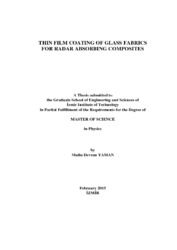Please use this identifier to cite or link to this item:
https://hdl.handle.net/11147/4299| Title: | Thin Film Coating of Glass Fabrics for Radar Absorbing Composites | Other Titles: | Radar Soğurabilen Kompozitler için Cam Elyafların İnce Film Kaplamaları | Authors: | Yaman, Mutlu Devran | Advisors: | Özyüzer, Lütfi | Keywords: | Radar absorbing composites Jaumann type radar absorbing structures Thin films |
Publisher: | Izmir Institute of Technology | Source: | Yaman, M. D. (2015). Thin film coating of glass fabrics for radar absorbing composites. Unpublished master's thesis, İzmir Institute of Technology, İzmir, Turkey | Abstract: | By the invention of radio and micro wave range in electromagnetic spectrum, some radar systems were started to use to predict the range, altitude, direction or speed of objects. During the Second World War, the scenario changed significantly and this led to the development of the radar absorbing materials (RAM’s). Then the stealth technology and Radar Cross Section (RCS) terminologies took place in science research area. To reduce of an objects detectability in the radar detection systems, the reduction of the radar cross section play an important role. For absorbing electromagnetic micro waves, radar absorbing materials have been developed and they consist dielectric and magnetic materials that has capacity for absorbing. In order to increase frequency range (bandwidth) of the absorbance, several materials have been already proposed by several researchers. But nowadays, studies on investigating the radar absorbing structures (RAS) using fiber reinforced polymeric composite materials, are becoming popular research field. The purpose of this study is to design, fabricate and characterize RAS’s based on unidirectional E-glass fiber reinforced epoxy resin composites which can absorb microwave within 2-20 GHz frequency range. Several Jaumann design composite structures were manufactured to achieve radar wave absorbance. In this Jaumann structures, we use different designs in terms of different resistive values of sheets and different thickness of composites. In addition to this, we also focused on the different concentration of additives and distance between resistive sheets. Glass fiber / epoxy system were employed as a base structure. Carbonyl Iron powders were used to change permittivity, permeability and intrinsic impedance values of the structure. To functionalize the glass fibers and to make them conductive, surface of them was metalized by using large area planar magnetron sputtering system. These conducting layers act as a resistive sheet within the composite structure. Surface resistances of resistive sheets used in structures show diversity between ≈ 430 ohms and to 30 ohms. | Description: | Thesis (Master)--Izmir Institute of Technology, Physics, Izmir, 2015 Full text release delayed at author's request until 2016.02.10 Includes bibliographical references (leaves: 130-137) Text in English; Abstract: Turkish and English |
URI: | http://hdl.handle.net/11147/4299 |
| Appears in Collections: | Master Degree / Yüksek Lisans Tezleri |
Files in This Item:
| File | Description | Size | Format | |
|---|---|---|---|---|
| T001329.pdf | MasterThesis | 12.07 MB | Adobe PDF |  View/Open |
CORE Recommender
Page view(s)
744
checked on Jun 16, 2025
Download(s)
1,152
checked on Jun 16, 2025
Google ScholarTM
Check
Items in GCRIS Repository are protected by copyright, with all rights reserved, unless otherwise indicated.